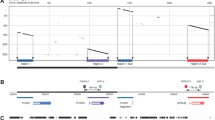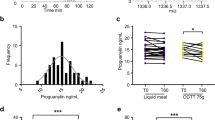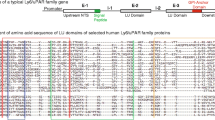Summary
The human transmembrane secretory component (SC) mediates glandular translocation of polymeric IgA and IgM into exocrine secretions. A 2898-bp cDNA clone, encoding the entire sequence of the human transmembrane SC, was isolated from a colonic adenocarcinoma cell line cDNA library. The deduced amino-acid sequence had a length of 764 residues and showed an overall similarity of 56% and 64% with the rabbit and rat counterpart, respectively. A restriction fragment length polymorphism (RFLP) was found with PvuII, revealing a two-alle RFLP with an autosomal codominant inheritance pattern and allele frequencies of 0.65 and 0.35. Southern blot analysis of human-rodent somatic hybrid panels, including hybrids with translocation chromosomes carrying different parts of chromosome 1, assigned the SC gene to 1q31-q42, thus confirming a previously reported provisional assignment.
Similar content being viewed by others
References
Balazs I, Purrello M, Kurnite DM, Grzeschik K-H, Siniscalco M (1984) Isolation and characterization of human random cDNA clones homologous to DNA from the X chromosome. Somatic Cell Mol Genet 10:385–397
Banting G, Brake B, Braghetta P, Luzio PJ, Stanley KK (1989) Intracellular targetting signals of polymeric immunoglobulin receptors are highly conserved between species. FEBS Lett 254:1771–1783
Barneveld R, Keijzer W, Tegelaers FP, Ginns EI, Geurts van Kessel A, Brady RO, Barranger JA, Tager JM, Galjaard H (1983) Assignment of the gene coding for human β-glucocerebrosidase to the region q21–q31 of chromosome 1 using monoclonal antibodies. Hum Genet 64:227–231
Botstein D, White RL, Skolnic M, Davis RW (1980) Construction of a genetic linkage map using restriction fragment length polymorphisms. Am J Hum Genet 32:314–331
Brandtzaeg P (1974) Presence of J chain in human immunocytes containing various immunoglobulin classes. Nature 252:418–420
Brandtzaeg P (1985) Role of J chain and secretory component in receptormediated glandular and hepatic transport of immunoglobulins in man. Scand J Immunol 22:111–146
Brandtzaeg P, Baklien K (1977) Intestinal secretion of IgA and IgM: a hypothetical model. In: Immunology of the gut. (Ciba Foundation Symposium 46) Elsevier/Excerpta Medica North-Holland, pp 77–113
Brandtzaeg P, Prydz H (1984) Direct evidence for an integrated function of J chain and secretory component in epithelial transport of immunoglobulin. Nature 311:71–73
Brito-Babapulle V, Atkin NB (1981) Break points in chromosome1: abnormalities of 218 human neoplasms. Cancer Genet Cytogenet 4:215–225
Bruns GAP, Sherman SL (1989) Report of the committee on the genetic constitution of chromosome 1. Cytogenet Cell Genet 51:67–90
Conley ME, Delacroix DL (1987) Intravascular and mucosal immunoglobulin A: two separate but related systems of immune defense? Ann Intern Med 106:892–899
Davidson MK, Le Beau MM, Eddy RL, Shows TB, DiPietro LA, Kingzette M, Hanly WC (1988) Genetic mapping of the human polymeric immunoglobulin receptor gene to chromosome region 1q31→q41. Cytogenet Cell Genet 48:107–111
Eiffert H, Quentin E, Decker J, Hillemeir S, Hufschmidt M, Klingmüller D, Weber MJ, Hilschmann N (1984) Die Primärstruktur der menschlichen freien Sekretkomponente und die Anordnung der Disulfidbrücken. Hoppe-Seyler's Z Physiol Chem 365:1489–1495
Feinberg AP, Vogelstein B (1984) A technique for radiolabeling DNA restriction endonuclease fragments to high specific activity Addendum. Anal Biochem 137:266–267
Geurts van Kessel AHM, Westerveld A, Groot PG de, Meera Khan P, Hagemeijer A (1980) Regional location of the genes coding for human ACO2, ARSA and NAGA on chromosome 22. Cytogenet Cell Genet 28:169–172
Hanson LÅ, Brandtzaeg P (1989) The mucosal defence system. In: Stiehm ER (ed) Immunologic disorders in infants and children, 3rd edn. Saunders, Philadelphia, pp 116–155
Krajči P, Solberg R, Sandberg M, Øyen O, Jahnsen T, Brandtzaeg P (1989) Molecular cloning of the human transmembrane secretory component (poly-Ig receptor) and its mRNA expression in human tissues. Biochem Biophys Res Commun 158:783–789
Krajči P, Meling GI, Taskén K, Rognum TO, Brandtzaeg P (1991) Studies on tissue-specific expression of mRNA for the human transmembrane secretory component and its regulation by cytokines. In: Tsuchiya M, Nagura H, Hibi T, Moro I (eds) Frontiers of mucosal immunology, vol 1. Elsevier, Amsterdam pp 307–310
Lublin DM, Lemons RS, Le Beau MM, Holers VM, Tykocinski ML, Meoob ME, Atkinson JPG (1987) The gene encoding decay-accellerating factor (DAF) is located in the complementregulatory locus on the long arm of chromosome 1. J Exp Med 165:1731–1736
Maniatis T, Fritsch E, Sambrook (1989) Molecular cloning: a laboratory manual, 2nd edn. Cold Spring Harbor Laboratory, Cold Spring Harbor, NY
Mestecky J, McGhee JR (1987) Immunoglobulin A (IgA): molecular and cellular interactions involved in IgA biosynthesis and immune response. Adv Immunol 40:153–245
Mostov KE, Blobel G (1982) A transmembrane precursor of secretory component. The receptor for transcellular transport of polymeric immunoglobulins. J Biol Chem 257:11816–11821
Mostov KE, Friedlander M, Blobel G (1984) The receptor for transepithelial transport of IgA and IgM contains multiple immunoglobulin-like domains. Nature 308:37–43
Ralph SJ, Thomas ML, Morton CC, Trowbridge IS (1987) Structure variants of human T-200 glycoprotein (leukocyte-common antigen). EMBO J 6:1251–1257
Rodrigues de Cordoba S, Lublin DM, Rubinstein P, Atkinson JP (1985) Human genes for 3 complement components that regulate the activation of C3 are tightly linked. J Exp Med 161:1189–1195
Sanger F, Nicklen S, Coulson AR (1977) DNA sequencing with chain terminating inhibitors. Proc Natl Acad Sci USA 74:5294–5299
Southern EM (1975) Detection of specific sequence among DNA fragments separated by gel electrophoresis. J Mol Biol 98:503–517
Tabor S, Richardson CC (1987) DNA sequence analysis with a modified bacteriophage T7 DNA polymerase. Proc Natl Acad Sci USA 84:4767–4771
Wang H, Wu J, Tang P (1989) Superfamily expands. Nature 337:514
Weis JH, Morton CC, Bruns GAP, Weis JJ, Klickstein LB, Wong WW, Fearon DT (1987) A complement receptor locus: genes encoding C3b/C4b receptor and C3d/Epstein-Barr virus receptor map to 1q32. J Immunol 138:312–315
Author information
Authors and Affiliations
Rights and permissions
About this article
Cite this article
Krajči, P., Grzeschik, K.H., van Kessel, A.H.M.G. et al. The human transmembrane secretory component (poly-Ig receptor): molecular cloning, restriction fragment length polymorphism and chromosomal sublocalization. Hum Genet 87, 642–648 (1991). https://doi.org/10.1007/BF00201717
Received:
Issue Date:
DOI: https://doi.org/10.1007/BF00201717




